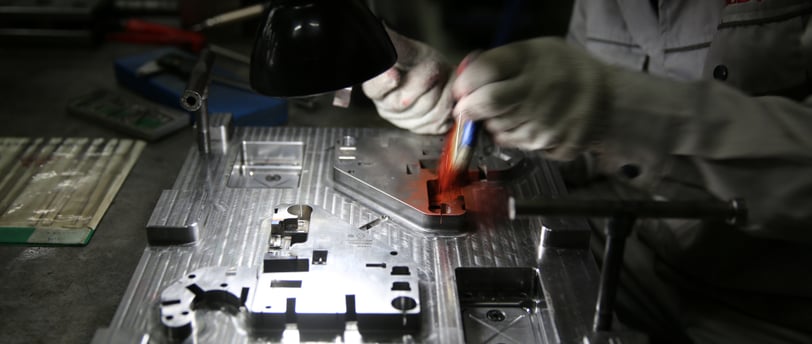Pressure Control Systems in Stamping Molds Explained
2/28/2025


Introduction to Stamping Molds
Stamping molds are critical components in the manufacturing sector, particularly in the metalworking industry. They serve as tools to shape and transform metal sheets into specific forms through a process known as stamping, which utilizes pressure to achieve desired configurations. The fundamental principle behind stamping involves the deformation of materials under force, ensuring that they can be molded into complex shapes while maintaining structural integrity. This process is widely recognized for its efficiency and precision, making it an essential technique in various applications.
There are several types of stamping processes, including blanking, bending, and piercing. Blanking involves cutting out shapes from a larger sheet of material, while bending entails altering the shape of a metal sheet at specific angles. Piercing, on the other hand, involves creating holes in the material. Each of these processes utilizes stamping molds differently, necessitating precise design and manufacturing of the molds to ensure accuracy in the final products. The choice of the stamping process largely depends on the design requirements and the intended application of the metal components.
The materials used in stamping can vary widely, often incorporating metals such as steel, aluminum, and brass, among others. The selection of these materials not only influences the performance of the stamping operation but also affects the durability and quality of the finished products. Stamping molds play a pivotal role in ensuring that these materials are processed accurately, facilitating high levels of precision and efficiency. Advanced techniques in mold design and construction can significantly enhance the productivity of the stamping process, ultimately contributing to the overall success of manufacturing operations.
Understanding Pressure Control Systems
Pressure control systems are integral components in stamping molds, designed to regulate and maintain the desired pressure levels during manufacturing processes. These systems ensure that the pressure applied during stamping is consistent and within specified tolerances, which is vital for producing high-quality components. At their core, pressure control systems utilize a combination of sensors, controllers, and actuators to monitor and adjust the pressure in real-time, ensuring that fluctuations do not compromise the stamping process.
The functionality of pressure control systems primarily hinges on their ability to detect variations in pressure levels and respond accordingly. Typically, these systems are equipped with pressure sensors that continuously measure the pressure within the mold cavity. When the system identifies a deviation from the preset pressure parameters, it activates controllers that adjust the pressure by modulating hydraulic or pneumatic inputs. This automatic adjustment process is crucial for maintaining the integrity of the mold and ensuring uniformity in the final product.
Applications of pressure control systems extend beyond simple mold regulation. In various manufacturing contexts, including automotive, aerospace, and electronic component production, precise pressure management is paramount. For instance, during the stamping of intricate parts, inadequate pressure can lead to defects such as warping or incomplete filling of the mold. Conversely, excessive pressure may cause material fatigue or premature failure of the mold itself. Therefore, integrating advanced pressure control systems minimizes production defects and enhances the overall efficiency of the manufacturing workflow.
The relationship between effective pressure regulation and the quality of stamped products cannot be overstated. By ensuring that pressure is distributed evenly and reliably across the stamping surface, manufacturers are better positioned to meet product specifications and maintain high standards of quality. In the dynamic landscape of modern manufacturing, adopting robust pressure control systems is essential for optimizing production outcomes and fostering innovation.
Components of Pressure Control Systems in Stamping Molds
Pressure control systems in stamping molds are vital in ensuring the accuracy and consistency of the manufacturing process. These systems comprise several key components that work in unison to maintain optimal pressure throughout the stamping operation. Understanding these components is essential for anyone involved in the design, maintenance, or operation of stamping molds.
One of the primary components of a pressure control system is the pressure sensor. These sensors monitor the pressure within the mold and provide real-time data to the control unit. They are crucial for detecting any deviations from the desired pressure levels, allowing for immediate corrective actions. By ensuring accurate pressure readings, pressure sensors improve the efficiency and quality of the stamping process.
Another integral component is the pressure control valve. These valves regulate the flow of hydraulic fluid or air within the system to adjust the pressure in the mold accurately. By responding to signals from the control unit, these valves can open or close, ensuring that the pressure remains within the specified range. Their ability to swiftly control the pressure is essential in preventing potential defects in the stamped components.
The actuators represent another critical element within the pressure control system. They convert control signals from the control unit into physical movement, manipulating the valves to align with the system's pressure requirements. Actuators can be hydraulic, pneumatic, or electronic, depending on the specific application and requirements of the stamping mold.
Lastly, the control unit manages the entire operation of the pressure control system. It receives data from the pressure sensors and uses this information to make decisions regarding the operation of the valves and actuators. The control unit plays a vital role in maintaining the stability of the pressure throughout the stamping cycle, ensuring that production runs smoothly and effectively.
Benefits and Challenges of Using Pressure Control Systems
Implementing pressure control systems in stamping molds provides significant advantages, greatly enhancing both the efficiency and quality of the manufacturing process. One of the primary benefits is the improvement in product quality. By meticulously regulating the pressure during the stamping process, these systems ensure that the materials are compressed evenly, leading to a reduction in defects such as warping or inconsistent dimensions. As a result, manufacturers can achieve higher precision and better meet quality standards, ultimately satisfying customer demands.
In addition to improved product quality, pressure control systems contribute to increased production efficiency. These systems facilitate faster cycle times through consistent and predictable pressure application, allowing for higher throughput in manufacturing operations. This acceleration enables companies to meet tight deadlines and scale production to accommodate market demands. Furthermore, by optimizing the use of materials and minimizing waste, pressure control systems also play a crucial role in enhancing overall operational efficiency.
Despite these notable benefits, several challenges and limitations accompany the adoption of pressure control systems. One of the primary concerns is the initial setup cost, which can be significant for companies looking to integrate this advanced technology into existing stamping processes. Additionally, these systems require regular maintenance to ensure continued precision and reliability, necessitating investment in both tools and skilled personnel capable of performing upkeep.
Lastly, successful implementation of pressure control systems involves comprehensive operator training to ensure that staff are well-versed in handling these complex technologies. This knowledge transfer is crucial, as ineffective or improper use can negate the benefits these systems offer. Consequently, companies must weigh the advantages of enhanced product quality and production efficiency against the upfront costs, ongoing maintenance, and training requirements associated with pressure control systems.
